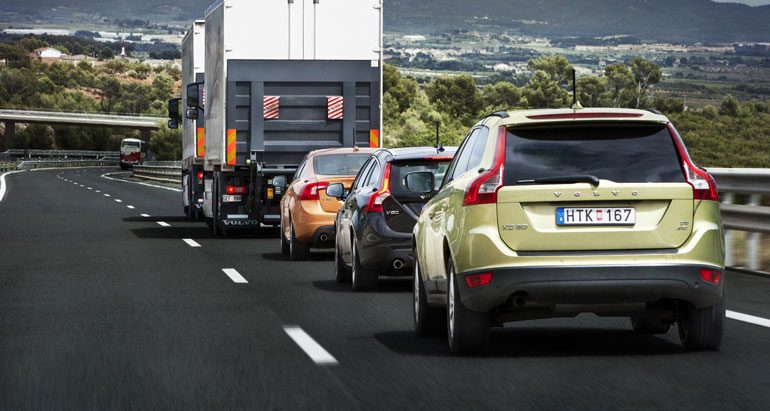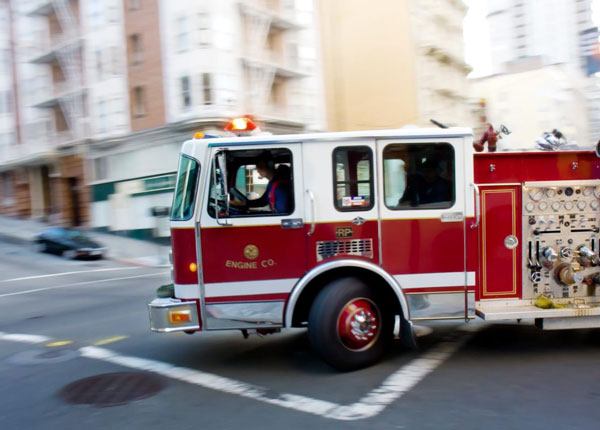
Sharing the Road with Large Trucks, Maintenance & Slow-Moving Vehicles
Updated Dec. 11, 2020To share the road safely with large trucks, you must keep in mind that these vehicles are heavy, have a wider turning circle, longer stopping distances and bigger blind spots. Remember that large trucks are designed primarily to transport cargo. They are not as maneuverable as smaller passenger vehicles.
Never pull out in front of a large truck and brake suddenly, as it is unlikely the truck driver will be able to stop quickly enough to avoid a collision. An average passenger car traveling at 55mph has a total stopping distance of approximately 240ft, whereas a fully-loaded cargo truck could take more than 400ft to come to a complete stop.
Off-tracking
When any vehicle turns, its rear wheels will take a shorter path than its front wheels; this is known as off-tracking. Long vehicles such as trucks have a much greater difference between the front and back wheel path-size when making a turn, compared to the average car. This phenomenon forces truck drivers to make wide turns. The longer the vehicle, the wider the turn will be.
 Big rig drivers must often swing wide to complete a right turn. When you follow a big rig, look at its turn signals before you start to pass.
Big rig drivers must often swing wide to complete a right turn. When you follow a big rig, look at its turn signals before you start to pass.Always give truck drivers plenty of time and room to complete a turning maneuver. It may seem as if they are continuing straight on or turning to the left, when they are preparing to make a right turn. Car drivers attempting to pass a turning truck - or driving in the truck’s right-hand blind spot - are common causes of collisions. Remain at a safe distance and do not try to pass a truck on the right.
Visibility and blind spots
All drivers must take care to avoid occupying blind spots or “No-Zones” around a truck or another large vehicle. Truckers may have a better view of the road ahead and larger mirrors, but their ability to see other vehicles driving close by is poor. Blind spots where your vehicle may not be seen include the spaces directly in front, directly behind and along either side of the truck – particularly the right side.
If you cannot see the truck driver’s reflection in their side mirror, it is likely you are in a “No Zone” and they cannot see you either. This puts you at significant risk of being involved in a collision. Always remember that the bigger the vehicle, the larger its blind spots.
Rear blind spot: Never follow a truck too closely; you can be seen by the truck driver if you maintain a safe distance. Come up too close and you will be completely obscured by the back end of the vehicle. Do not pass behind a truck that is reversing or preparing to reverse for this same reason.
Front blind spot: Maintain a safe distance when changing lanes in front of a truck. Do not merge until the entire front of the truck is visible in your rear-view mirror. Always signal before changing lanes and never pass a truck on the right.
Side blind spots: Avoid the long blind spots on either side of the truck. Should the truck driver have to make an emergency maneuver or suddenly switch lanes, your vehicle will be in the way - and not visible – when occupying one of these spaces.
Tailgating trucks
Under no circumstances should you tailgate a truck. Tailgating any vehicle is dangerous as you will not have enough space to slow down and avoid a collision, if the driver in front of you stops suddenly. Tailgating a truck is a particularly bad idea, as it will likely block your view of the road ahead and your ability to spot any hazards. Plus, it will land your car right in the middle of the truck’s rear blind spot.
 When you follow so closely behind a truck that you cannot see the truck driver’s side view mirrors, the trucker cannot see you and has no way of knowing you are there.
When you follow so closely behind a truck that you cannot see the truck driver’s side view mirrors, the trucker cannot see you and has no way of knowing you are there.Passing trucks
Cutting off a truck in traffic or on the highway is an extremely dangerous move. A great many collisions are caused by impatient passenger vehicle drivers attempting to make a last-minute exit or beat a truck driver to a single-lane construction zone. Always remember that your life is more than worth the few extra seconds it will take to slow down and take your turn.
You can pass trucks and large vehicles safely with the following rules:
- 1

Check to the front and rear of your vehicle before moving into the passing lane.
- 2

Signal to the truck driver than you intend to pass by blinking your headlights, especially at night.
- 3

Always pass trucks on the left side, to maintain maximum visibility.
- 4

Do not linger in the truck’s blind spot as you pass.
Complete your pass as quickly as is safely possible. - 5

Never pass a truck on a downward slope.
The weight and momentum of the truck will cause it to increase speed.
Being passed by a truck
Passing trucks can create strong gusts of wind that can push you out of your lane, off the road, or otherwise affect the control of your vehicle. Be aware of this phenomenon whenever a truck passes you, keeping both hands on the steering wheel until it has safely moved away.
Size and speed
When car-truck collisions happen at intersections, it is often because the car driver overestimated the distance between themselves and the truck, and underestimated the speed at which it was traveling. Large vehicles usually appear to be further away and traveling slower than they actually are! If a truck is approaching you from the opposite direction on a two-way road, it is wise to move as far to the right as possible. This should protect you from a sideswipe collision if you have underestimated its size.
Escape ramps
You may sometimes see escape or runaway truck ramps on the highway. These are designed for truck drivers and drivers of large vehicles who have lost the ability to brake, giving them a chance to avoid a fatal accident. Escape ramps are most commonly found toward the end of a long downgrade, where the build-up of momentum may be too much for a large vehicle’s brakes to bear. Drivers must never block or park in an escape ramp. Doing so could cause a catastrophic collision.
 Escape ramps are made to stop runaway vehicles safely without injuring drivers and passengers. Escape ramps use a long bed of loose, soft material to slow a runaway vehicle, sometimes in combination with an upgrade.
Escape ramps are made to stop runaway vehicles safely without injuring drivers and passengers. Escape ramps use a long bed of loose, soft material to slow a runaway vehicle, sometimes in combination with an upgrade.Hazardous loads
Truck drivers that are transporting a dangerous load must display a yellow, diamond-shaped warning sign on the back of their vehicles for other road users to see. A picture or symbol which identifies the cargo will be in the center of the diamond.
As hazardous material vehicles could be carrying flammable, explosive, radioactive, corrosive or poisonous substances that would be devastating to human health and the environment in the event of an accident or collision, it is best to allow these vehicles additional space wherever possible. Keep in mind that hazardous material carrying trucks must stop at every railway crossing by law. Be prepared to stop when following a vehicle bearing a hazmat placard approaching a railroad.
Large maintenance vehicles
Drivers must always yield the right-of-way to service vehicles carrying out maintenance work on the roads. Always approach, overtake and pass maintenance trucks and other such vehicles with additional caution. Passing snowplows can be particularly dangerous, as large clouds of snow are often kicked-up in their wake, concealing them from other road users.
Slow-moving vehicles
Slow-moving vehicles that are designed to travel at a speed of 25mph or less will be marked with an orange, triangular emblem. This includes farm tractors, animal-drawn vehicles and road maintenance vehicles.
Some particularly large trucks may also bear the slow-moving vehicle sign. Other trucks that are not marked as slow-moving vehicles may use their flashers to alert drivers around them that they are moving slowly, while on long slopes and steep upgrades.
Drivers should be on the lookout for slow-moving vehicles and adjust their speed accordingly when approaching them. Exercise patience around slow vehicles, do not sound your horn or attempt to overtake them unless it is safe to do so.




